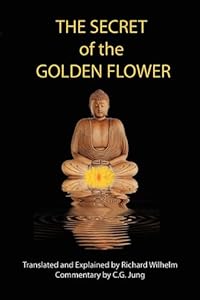The Secret of the Golden Flower a Chinese Taoist book about meditation, was translated by Richard Wilhelm (also translator, in the 1920s, of the Chinese philosophical classic the I Ching). Wilhelm, a friend of Carl Jung, was German, and his translations from Chinese to German were later translated to English by Cary F. Baynes.
According to Wilhelm, Lü Dongbin was the main originator of the material presented in the book (a section below, Reception from Chinese Taoists, suggests that the material is from Quanzhen School founder Wang Chongyang, a student of Lü Dongbin). More recently (1991), the same work has been translated by Thomas Cleary, a scholar of Eastern studies.
There are significant differences between the Wilhelm and Cleary translations. Wilhelm was introduced to the work by his Chinese teacher, while Cleary arrived at his own translation and interpretation. Some translations are given with the word mystery for the word secret in the treatise's title.
Classic works of Chinese philosophy preserve a spectrum of pre-modern science, from a time when philosophy and science were less distinct than they appear to be now. The foundations of their teachings often appear incompatible with modern science, yet the teachings are of significant efficacy in providing a degree of awareness that might otherwise remain obscured by modern society’s attention to more stringent standards of rational thought (for a further discussion of possible benefits, see Meditation).
To use Chinese terms, these philosophical works include yin thought with yang thought, that is, they reflect intuitive as well as rational perception. Intuitive perception accumulates and improves with practice and time. Rational thought benefits from an enhanced acuity of intuitive perception.
According to Wilhelm, Lü Dongbin was the main originator of the material presented in the book (a section below, Reception from Chinese Taoists, suggests that the material is from Quanzhen School founder Wang Chongyang, a student of Lü Dongbin). More recently (1991), the same work has been translated by Thomas Cleary, a scholar of Eastern studies.
There are significant differences between the Wilhelm and Cleary translations. Wilhelm was introduced to the work by his Chinese teacher, while Cleary arrived at his own translation and interpretation. Some translations are given with the word mystery for the word secret in the treatise's title.
Classic works of Chinese philosophy preserve a spectrum of pre-modern science, from a time when philosophy and science were less distinct than they appear to be now. The foundations of their teachings often appear incompatible with modern science, yet the teachings are of significant efficacy in providing a degree of awareness that might otherwise remain obscured by modern society’s attention to more stringent standards of rational thought (for a further discussion of possible benefits, see Meditation).
To use Chinese terms, these philosophical works include yin thought with yang thought, that is, they reflect intuitive as well as rational perception. Intuitive perception accumulates and improves with practice and time. Rational thought benefits from an enhanced acuity of intuitive perception.

No comments:
Post a Comment